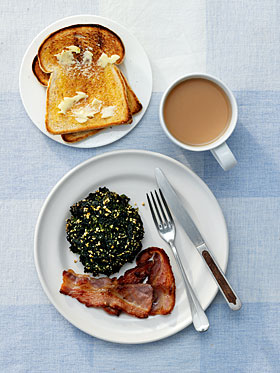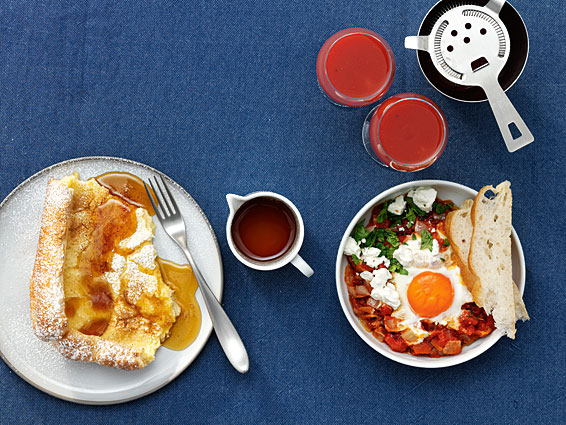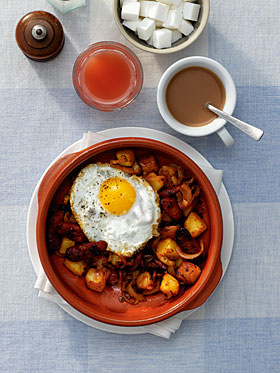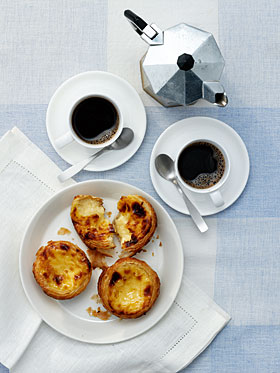The meaning of breakfast

Simply sign up to the Life & Arts myFT Digest -- delivered directly to your inbox.
In 2005 some friends and I started a website called The London Review of Breakfasts. We loved going out for breakfast but had recently been faced with a lot of bad ones (limp bacon, lukewarm tea, apathetic egg …).Because nobody in the dinner-obsessed media was writing about the day’s foremost meal, we thought it would be fun to do so ourselves. Especially if we wrote using pen names made from breakfast puns like Blake Pudding, Tina Beans and Malcolm Eggs. One morning, I logged on, posted something about the pleasures and pitfalls of eating out for breakfast, and the website was born.
Strange things began to happen. People I didn’t know got in touch, inquiring whether they too might assume secret identities and share their morning-meal experiences. On planes and in pubs, everyone to whom I mentioned the subject wanted to tell me their breakfast routine (“I have this unbelievable poached egg method …”) in meticulous detail. Increasingly, it felt as though we had hit on something big: a vast, untapped reservoir of emotion, hidden in plain view, in the way we eat this bacon-and-eggy, marmaladey meal.
My interest began to mushroom. It was no longer enough to find excellent places serving breakfast; I wanted to understand what it meant. Have we always eaten the same thing at breakfast-time? What do they eat in India, China, the Middle East?
The sun, after all, is always rising somewhere, which means breakfast is always just about to happen. Dinner-time in Dakar is breakfast-time in Brisbane. In the Middle East, a breakfaster may enjoy piping-hot, mashed fava beans. In Hong Kong, he might sip on yuanyang, a tea-coffee combination whose name refers to the conjugal love of Mandarin ducks. Wherever you go, the wonderful monotonies of morning food are played out in a slightly different way that reflects the idiosyncrasies of both a place and its people.
When we (fellow LRB contributors Emily Berry, Richard Godwin, Henry Jeffreys, Peter Meanwell and myself) began exploring the international breakfasting classics, we wondered whether there was a common theme to be found, some universal stamp of breakfasthood that appears whatever the culture. But it is very hard to draw a straight line through congee rice, fried seaweed and Pop-Tarts. If we like breakfast, it’s because of the way in which, in the small variations we make – banana or blueberries with our pancakes? Feta or halloumi on our shakshuka? – we get to quietly reveal who we are.
Today we are constantly being told that there is no free time in the morning. Modern life is just too busy: breakfast should be taken on the move or at a desk. It means that breakfast has somehow turned into an act of defiance. We have forgotten the wise advice of Henry Wheeler Shaw: “If you have to work before breakfast, eat your breakfast first.”
Incidentally, when did you last invite someone over for breakfast? Never forget what a powerful gesture it can be. Thomas Babington Macaulay observed that: “Dinner parties are mere rituals; but you invite a man to breakfast because you really want to see him.” Few things can cement a friendship or relationship more firmly than a shared breakfast. Indeed, if the invite is delivered skilfully enough, the consequences can be profound:
“Jesus said to them, ‘Come and have breakfast.’ Now none of the disciples dared ask him, ‘Who are you?’ They knew it was the Lord.” That’s John 21:12. Now, come and have breakfast.
——————————————-
‘The Breakfast Bible’ by Seb Emina and Malcolm Eggs is published by Bloomsbury on February 11 (£16.99)
FT Reader special offer: To order “The Breakfast Bible” at 25 per cent off visit www.bloomsbury.com/uk/the-breakfast-bible-9781408804810/ or call 01256 302 699 quoting reference GLR 8JG. Offer ends March 15 2013
——————————————-
Laverbread and bacon

When swimming off the British Isles it is not uncommon to feel the silken yet slimy embrace of some horrifying undersea behemoth around your thighs, prompting unseemly amounts of panicking until the revelation dawns that it was just a bit of seaweed. Laverbread (bara lawr in Welsh) is its edible incarnation in which the seaweed, Porphyra umbilicalis, is boiled for hours to achieve a unique consistency. It has nothing to do with bread. Popular once in South Wales and parts of Cornwall, it is too mucus-like to be served much these days. But mixed with a little fine oatmeal and fried off in bacon fat, it can be rather delicious if texturally challenging, tasting like a fragrant day at the seaside. For the brave, and the Cornish, add a dash of vinegar and serve cold.
Laverbread is available to buy in small tins, or fresh from some markets (try www.thefishsociety.co.uk; or Carol Watts at www.swanseaindoormarket.co.uk).
Per person
100g laverbread
30g medium oatmeal
4 rashers streaky bacon
• Mix the laverbread with the oatmeal and form four small cakes about 1cm thick. Fry the bacon, and once removed, cook the cakes in the hot bacon fat.
• They may need a bit of attention to stop them sticking on the bottom. Fry for 2-3 minutes on each side until golden. They should be slightly crunchy on the outside and soft in the middle.
• Serve with the bacon, and some mushrooms, cockles and a fried egg.
…
Grits
Grits exert a morbid fascination over non-Americans. Why is a popular food named after gravel? What are they? Something no one seems to ask is “Where can I try some?” There is a general assumption that they are not nice.
Which is wrong. They’re very nice. A savoury porridge made from cornmeal, grits are a deeply comforting breakfast food. Their contemporary heartland is the Deep South, where some will insist you must use meal that is coarse and stone ground (hence the grittiness of the name). As well as regular corn grits (which is what we mean when we just say “grits”) you may have heard of hominy grits, in which the corn kernels are first treated with slaked lime.
Best served with butter plus salt and pepper, they can be liquid and untidy or tame and firm. Either way they play the carb role well in a trio alongside bacon and fried eggs.
If eating them solo, you can’t with good Southern conscience add sugar, but if you find them too bland then grated mild cheese is an endorsed embellishment.
Stone-ground cornmeal (sometimes just labelled “grits”) is tricky to find in the UK, so stock up when you can. Sachets of instant grits are sometimes found in specialist shops.
Serves 1
250ml water
50g grits (ie coarse stone-ground cornmeal)
Knob of unsalted butter
Salt and pepper
• Bring the water to the boil with ¼ teaspoon salt in a heavy-based saucepan. Add the grits, and lower the heat, stirring gently until the mixture starts to thicken. Then cover and stir occasionally, until the grits have softened and the mixture is creamy. If the mixture gets too dry add more water.
• Different grits cook for different times (it can take as little as five minutes or as much as 90 minutes) so check the packet. When you are happy with the texture, serve in a bowl with the knob of butter sat on top, and season well. Mix well before eating.
…

German pancakes
“German pancakes”, they call them – when to any Englishman they are quite patently Yorkshire puddings. Yorkshire puddings, however, are only eaten for breakfast in very limited circles. Not so German pancakes, because the Germans do not limit them to roast beef. They treat them as sweets – adding cinnamon, sugar and lemon, raisins and apples – and as savouries, sometimes adding bacon to the batter. Sausage could be added, too – then you would be eating toad-in-the-hole for breakfast, which is perhaps taking things a bit too far. The recipe here is adapted from Jane Grigson’s English Food.
Makes around 6 pancakes
1 tbs unflavoured oil (sunflower, groundnut, grapeseed)
4 medium eggs
300ml milk
250g plain flour, sifted
Pinch of salt
Icing sugar, sifted
• Pre-heat the oven to 250C/the highest your oven will go. Coat a hardy metal roasting tin with a film of oil and put it into the oven to heat up. Beat the eggs and the milk together vigorously – an electric whisk helps. Leave to stand for 15 minutes or so, then whisk in the sifted flour and the salt. You will have a thin batter. Pour this batter into the hot roasting tin and leave in the oven for 20 minutes. It will rise splendidly! And then gently collapse.
• As it is collapsing, sift over icing sugar. Serve with maple syrup and perhaps some baked apple slices, or any of the suggestions mentioned above.
…
The Bloody Mary
The origins of Bloody Mary are a little cloudy but all stories point to New York. An actor named George Jessel invented a primordial version consisting of just tomato juice and vodka. Finesse and kick in the form of Worcestershire sauce and cayenne pepper were introduced by Fernand Pietot, a barman at Harry’s New York Bar.
Modern recipes range from the sublime to the ridiculous. At the core of them all lie Jessel’s vodka and tomato juice, usually with a tot of lemon juice, and sometimes a dizzying array of spice configurations, many of which over-complicate the matter. This drink has been too often ruined by the mediocrity of the pub Bloody Mary so we turned our gaze back to Harry Craddock’s Savoy Cocktail Book (1930) for inspiration. What we’ve created is a breakfast sharpener worthy of its cocktail status that is lighter and less soup-like than its public-house comrades, but infinitely more electrifying. This will open the palate and burst through the clouds of a hangover.
The perfect recipe uses the sweetness of home-roasted tomatoes but if this is too arduous then use shop-bought tomato juice.
Serves 2
1kg very ripe vine cherry tomatoes (to roast and achieve 120ml tomato juice)
Salt and pepper
90ml vodka
30ml freshly squeezed lemon juice
1 dessertspoon dry sherry
Couple of drops of Worcestershire sauce
• Halve the cherry tomatoes, season liberally and roast in a warm oven (200C/gas 6) until on the verge of blackening, about 20 minutes. Blend and push through a sieve. Chill the strained juice.
• Combine all the remaining ingredients with the tomato juice in a cocktail shaker (if using pre-packaged tomato juice, then add a pinch of sugar, salt and pepper). Shake with ice and strain into stemmed glasses. Best enjoyed before breakfast is served.
…
Shakshuka
A crimson swamp peppered with eggs resembling crash-landed UFOs, shakshuka has much in common with menemen from Turkey. A popular dish in Israel, its exact history is gloopy – Morocco, Libya, Egypt and Yemen have all claimed to be shakshuka’s birthplace. There are countless different formulae but important constants are the kick of hot spice, the soft sweetness of tomato sauce and, of course, the egginess of the eggs. Tasty flourishes include scattering crumbled feta or grilled halloumi on top of each serving.
Serves 3-4
½ tsp cumin seeds
80ml olive oil
2 medium onions, finely chopped
1 green chilli pepper, stemmed, deseeded and finely chopped
1 red sweet pepper, deseeded and finely chopped
2 tsp muscovado sugar
1 tbs chopped thyme leaves
3 tbs chopped coriander leaves
2 tbs chopped flat-leaf parsley
1 x400g tin chopped tomatoes
½ tsp cayenne pepper
6 medium eggs
Salt and pepper
Soft white bread, to sop
• Heat a large frying pan over a medium-high heat. Add the cumin seeds and dry-fry for 2 minutes. Add the olive oil and allow it to heat up, then add the onion and green chilli and cook for 2 minutes.
• Throw in the red pepper, sugar, thyme and all but 1 tablespoon each of the coriander and parsley. Cook on a medium-low heat for a further 5 minutes.
• Add the tomatoes and cayenne, then season, and turn the heat down. Leave for 15 minutes, but keep checking on it – if it’s getting dry, add a little water.
• Now break the eggs into the mix so they are more or less evenly spaced.
• Cover the pan and leave gently cooking for 5 minutes, or until the white has cooked but the yolk still has a bit of run to it. Sprinkle on the rest of the parsley and coriander, and serve with some bread close to hand.
…
Chorizo hash

This filling and cheap dish is traditionally served in bars in Madrid. The Madrileños would be shocked to see it served as a breakfast dish as they tend only to consume caffeine and sugar in the morning, but on a rainy day in London it makes perfect sense.
You could add some morcilla (Spanish black pudding) at the same time as the chorizo, or some red peppers with the onions; this is one of the few times when adding garlic to a breakfast dish would not be a heresy. Serve each with a fried egg.
Serves 4
200g uncooked chorizo
500g potatoes (any kind), washed
2 medium onions
Salt and pepper
• Cut the chorizo into bite-sized slices. In a frying pan cook the chorizo slices over a medium heat for about 5 minutes each side. The chorizo is done when the pan is swimming with melted fat and the slices are crisped a little on each side. Meanwhile cut the unpeeled potatoes into 1cm cubes and parboil for 8-10 minutes until just underdone.
• With a slotted spoon remove the chorizo and drain most of the fat into a container for use later. Slice the onions, and add to the fat remaining in the pan. Let the onion cook for about 10 minutes or until it is lightly browned.
• Remove from the pan with a slotted spoon. Add some more of the saved chorizo fat to the pan and over a medium-high heat brown the potatoes in batches. When the potatoes are all browned return the onion and chorizo to the pan and heat through for 5 minutes. Season with salt and pepper.
…
Channa masala and poori
Around a billion breakfasts are eaten every day in India and, as you’d expect, depending on where you are, they tend to be quite different. In Mumbai the street vendors do a roaring trade in simple, carb-laden waada pavs (potato fritters in bread rolls) while in Kerala you may mark the morning with a paal-appam pancake made from rice flour fermented in wine and served with a meat or vegetable stew, or perhaps just a fried egg.
This breakfast comes from the Punjab via food blogger Sanjana Modha (for more of this kind of thing see www.korasoi.com). You’ll be making little deep-fried breads served with chickpeas in tomato sauce. The sauce is a hero – subtly complex, perfectly balanced and with a graceful kick.
Chai is your tea of choice here.
Serves 2-4
For the poori (little fried breads)
400g chapatti flour
2 tbs fine semolina
½ tsp salt
¼ tsp ground turmeric
¼ tsp chilli powder (or to taste)
1 tbs softened ghee or sunflower oil
Around 175ml boiled water
Sunflower oil, for deep-frying
For the channa masala
400ml tomato passata
3 tbs concentrated tomato purée
200ml milk
1 garlic clove, crushed (½ teaspoon)
2 tsp grated fresh root ginger
½ tsp red chilli powder (or to taste)
2 tsp ground coriander
½ tsp ground cumin
1 tsp ground fennel seeds
1½ tsp caster sugar
1 tsp salt
240g tinned chickpeas, rinsed and drained
2 tbs thick Greek yoghurt
3 tbs freshly chopped coriander
• To make the poori, first boil the kettle. Mix together all of the dry ingredients and make a well in the centre of the flour. Add the ghee or sunflower oil and gradually incorporate the water, combining with a spoon until the mixture comes together into a firm but pliable dough. When cool enough to handle, bring together with your hands and knead for 5 minutes until stickiness has given way to firmness. Cover and allow to rest for 10 minutes. Now is a good time to mix the channa masala and put it on the heat.
• In a large bowl whisk together everything but the chickpeas, yoghurt and coriander. Pour into a wide saucepan and bring the sauce to a boil. Cover and simmer on a medium/low heat for 10 minutes. Uncover and stir periodically to ensure it doesn’t stick.
• Add the chickpeas, cover again and simmer for a further 5 minutes. Uncover and allow to cool for 5 minutes. Finally, quickly whisk in the yoghurt and chopped coriander. Remember to be swift – the yoghurt should not split in the curry.
• Knead the poori dough again and divide into ping-pong-sized balls. Roll each ball on a very lightly oiled surface to a disc around 10cm in diameter. Heat enough oil to deep-fry the pooris (a wok can be useful here) to about 180C but, as always when dealing with a lot of hot oil, be careful and don’t fill your pan or wok to more than a third of the way up.
• Add two or three pooris to the oil at a time, gently agitating them with a slotted spoon, until golden on both sides. Remove with a slotted spoon and drain on kitchen paper. Repeat for the remaining pooris and keep hot. Serve the hot pooris with the channa masala and chai.
…
Baozi
The Chinese warlord Zhuge Liang is tramping with his army through the mountains, somewhere in the third century AD. Having just conquered all of Sichuan, they reach a torrid-looking river when suddenly the wind whips up, the rain pours and the sky darkens. The river demon, say the locals, is causing havoc and the sacrifice of a human head will be required to find a way across. Zhuge, tired of all the heads he has already rolled to subdue Sichuan, settles on a culinary solution. He creates a head-shaped dough bun that, thrown into the river, somehow mollifies the fiend. Implausibly, the “barbarian’s head” or mantou bun is born and subsequently becomes very popular. The idea of popping a filling in the middle catches on, and the name baozi is coined – bao means “to wrap”.
Ubiquitous across Asia, baozi (China), mandu (Korea), nikuman (Japan), bánh bao (Vietnam) or siopao (Philippines) can have as many fillings as there are names, from minced pork and char siu to sweet azuki bean or lotus paste. Some are even filled with a steaming hot soup that must be sucked from a small hole bitten into the top.
They are surprisingly easy to make, giving you maximum control over how you fill your “barbarian’s head”. Use bamboo steamers if you have them.
Makes 8
For the dough
300g strong white bread flour
1 tsp dried instant yeast
Pinch of salt
1½ tbs caster sugar
180ml warm water
1 tbs vegetable oil
filling of choice (see below)
• Sieve the flour into a bowl, and add the dried yeast and salt. Dissolve the sugar in the warm water, and stir in the oil. Make a well in the centre of the flour, and mix in the sugary, oily water. It should come together into a sticky dough.
• Turn the dough out on to an oiled work surface and knead until smooth and elastic, this should take 10-15 minutes. Roll out the dough into a sausage shape about 5cm in diameter, and cut into eight rounds. Sit the little loaves on a sheet of baking paper (not on the cut sides) and leave to prove for about 20 minutes. They’ll puff up slightly, and air bubbles should be visible on the cut sides. You can then either steam them as they are, for fluffy slightly sweet rolls, or you can add a filling.
• To fill, roll each piece of dough into a round about 15cm in diameter. Make a circle with the index finger and thumb of one of your hands and lay the dough on top. Create an indent in the round’s centre, pushing it down gently through the circle, being careful not to stretch the dough too much.
• You should now have an upside down bowler hat in your open fist. Into the indent add a dessertspoon of your filling, then bring the edges up around the filling to wrap the contents and twist the edges together to seal.
• Sit the filled bun on a lightly oiled square of baking paper, and leave 20 minutes. Arrange your bamboo steamers over a rapidly boiling pot of water, and add the buns on their squares of paper. Don’t overcrowd the steamer – they will nearly double in size. Steam for 15 minutes, remove and eat hot.
• If you have leftover dough, it will keep overnight in a sealed container in the fridge. You’ll need to knock it back, roll out and leave to prove again. Fillings can be made in advance and kept chilled.
Three fillings (each makes 4)
The joy of the homemade baozi is that you can fill it with whatever takes your fancy. Here are a few, traditional and otherwise, but experiment.
The classic baozi has a minced pork-based filling, but the vegetable version is delicious too. In the spirit of cultural closeness we have devised an elaborate full English baozi, a recipe we believe has never been tried on the streets of China or anywhere else for that matter.
Spiced pork
100g minced pork
1 large mushroom (preferably shiitake)
2 spring onions
1 garlic clove
1 walnut-sized piece of fresh root ginger, grated
1 tsp sesame oil
Dash of mirin (or sherry)
1 tbs soy sauce
• Finely chop the mushroom, onions and garlic, and mix with the ginger and minced pork. Add the oil, mirin and soy sauce and leave for at least an hour to marinate. When adding to the dough take care not to add too much liquid with the filling. Steam as per the recipe.
Vegetable
100g firm tofu
Handful of washed spinach
Handful of beansprouts
½ large mushroom (preferably shiitake)
2 spring onions
1 garlic clove
1 walnut-sized piece of fresh root ginger, grated
1 teaspoon sesame oil
Dash of mirin (or sherry)
1 tbs soy sauce
• Roughly chop all the ingredients, and add the liquids, combine well and leave at least an hour to marinate. Steam as per the recipe.
Full English
Meat from 2 sausages
4 rashers streaky bacon, chopped
1 flat mushroom, diced
1 slice black pudding, diced
2 spring onions, chopped
2 tsp vegetable oil
Ketchup or mustard
4 medium egg yolks
• In a bowl, mix the sausage meat with the bacon, mushroom, black pudding, spring onion and oil.
• When you have rolled the dough out into a circle, smear it with ketchup or mustard, then apply a thin layer of sausage mix – leaving a couple of centimetres of dough clean round the edge. Next, scoop up the dough in one hand so it forms a container.
• Gently add an egg yolk into the basket of meat, and pinch the dough together to seal the bun. You have to watch that you leave enough dough around the edge to seal without squashing the yolk. Steam as per the recipe.
…
Pastéis de nata

Belém, a pleasant estuarine district of Lisbon, has very important tarts: pastéis de Belém – small puff pastry cups of sweet custard with scorched, caramelised tops. Only tarts made to a secret recipe at the Antiga Confeitaria de Belém patisserie can be called pastéis de Belém, with others being pastéis de nata, mere “tarts of custard”.
The secret pastéis de Belém recipe was devised early in the 19th century by a group of enterprising local monks, before being astutely snapped up by the patisserie when the monastery closed. To this day it remains the sole knowledge of four people, a manager and three trusted bakers, who always prepare the pastries in a locked room. The tarts of Antiga Confeitaria de Belém have remained uniquely fine for almost 200 years.
But even if pastéis de nata are something of a tart-world pirate DVD, they still taste excellent enough to have gained a place on the world’s café counters. Here’s one way, which kindly evades the need to assemble puff pastry from scratch.
Makes 12 tarts (in a standard 12–hole muffin tray)
250g all-butter puff pastry
Unsalted butter, for greasing
For the custard
350ml milk
2 tbs plain flour
50ml double cream
4 large egg yolks
150g caster sugar
½ cinnamon stick
3 strips lemon peel
½ tsp vanilla extract
• Preheat the oven to 220C/gas 7. Put around 2 tablespoons of the milk into a saucepan then sift in the flour, before tipping in the rest of the milk as well as the cream, egg yolks and sugar. Stir together until completely smooth before introducing the cinnamon, lemon peel and vanilla extract. Turn the heat on, but low, and stand there stirring the mixture until it all thickens into gloopy, wonderful custard. Put it in a bowl and leave to one side.
• Grease your muffin tray with butter. Roll out the puff pastry on a floured surface so it’s around 3mm thick. Cut it into rounds slightly bigger than the muffin cups, and use them to line the muffin cups. Pour the custard into each one but not quite to the top of the pastry.
• Place the tray in the oven. After 25 minutes the tarts will start to brown a little on top. Finish this process under the preheated grill, then cool the tarts on a wire rack. Best eaten while still warm.
Comments